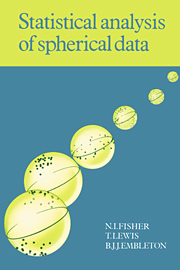Book contents
- Frontmatter
- Contents
- Preface
- 1 Introduction
- 2 Terminology and spherical coordinate systems
- 3 Descriptive and ancillary methods, and sampling problems
- 4 Models
- 5 Analysis of a single sample of unit vectors
- 6 Analysis of a single sample of undirected lines
- 7 Analysis of two or more samples of vectorial or axial data
- 8 Correlation, regression and temporal/spatial analysis
- Appendix A Tables and charts
- Appendix B Data sets
- References
- Index
3 - Descriptive and ancillary methods, and sampling problems
Published online by Cambridge University Press: 06 January 2010
- Frontmatter
- Contents
- Preface
- 1 Introduction
- 2 Terminology and spherical coordinate systems
- 3 Descriptive and ancillary methods, and sampling problems
- 4 Models
- 5 Analysis of a single sample of unit vectors
- 6 Analysis of a single sample of undirected lines
- 7 Analysis of two or more samples of vectorial or axial data
- 8 Correlation, regression and temporal/spatial analysis
- Appendix A Tables and charts
- Appendix B Data sets
- References
- Index
Summary
Introduction
The contents of this chapter constitute a tool-kit for use in the subsequent chapters on data analysis. §3.2 deals with some basic mathematical methods for vectors and matrices; §3.3 and §3.4 are concerned with methods of data display, and qualitative (or descriptive) features of spherical data sets. In particular, the basic method we have adopted for displaying vectorial data, which may cover both hemispheres, is explained in §3.3.1. §3.5 describes some standard statistical methods for deciding whether a given random sample of observations is adequately fitted by some specified probability distribution, and whether two independent samples have been drawn from the same (unspecified) distribution; §3.6 describes the use of simulation as an aid in complicated analyses; §3.7 describes jackknife procedures and permutation tests; and §3.8 is a brief discourse on problems of data collection.
The mathematical results presented in §3.2 are purely for reference purposes, and no derivations are given; most, if not all, of the results are available in standard texts.
Mathematical methods for unit vectors and axes in three dimensions
Mean direction, resultant length and centre of mass
Consider a collection of points P1, …,Pn on the surface of the unit sphere centred at O, with Pi corresponding to a unit vector with polar coordinates (θi, φi) and direction cosines xi, = sin θi, cos φi, yi = sin θi, sin φi, zi, = cos θi, i = 1,…, n.
- Type
- Chapter
- Information
- Statistical Analysis of Spherical Data , pp. 29 - 66Publisher: Cambridge University PressPrint publication year: 1987

